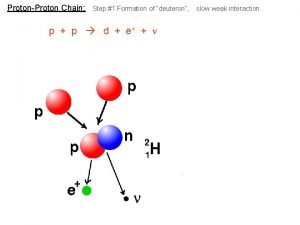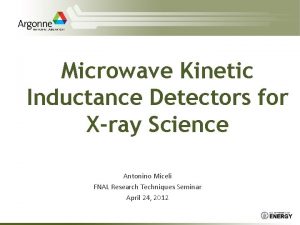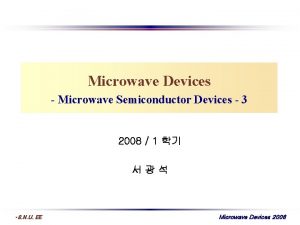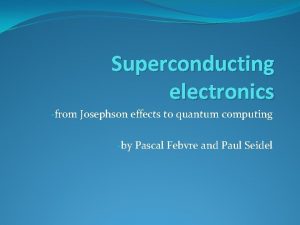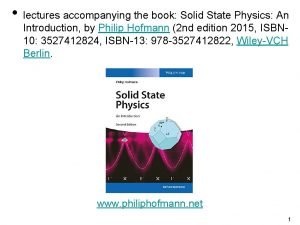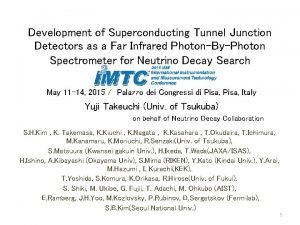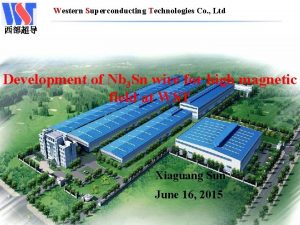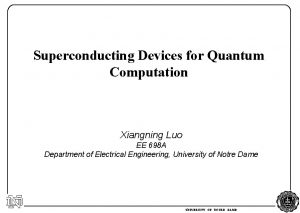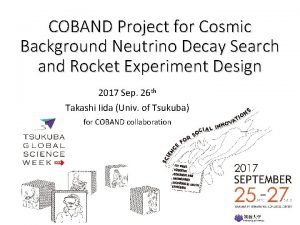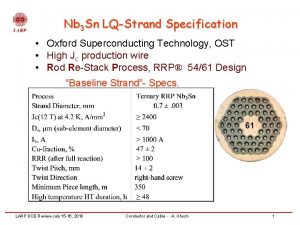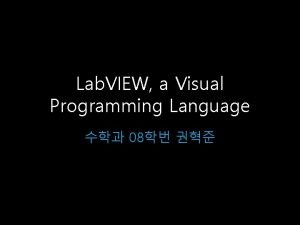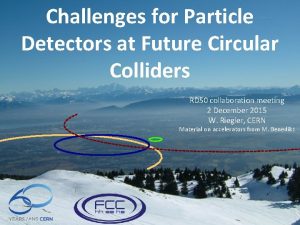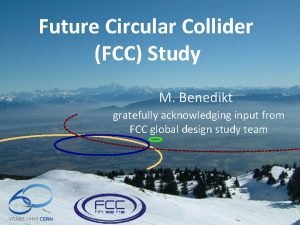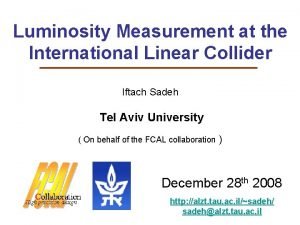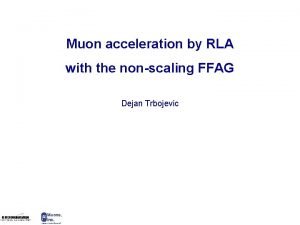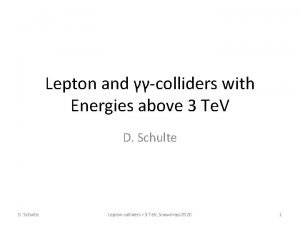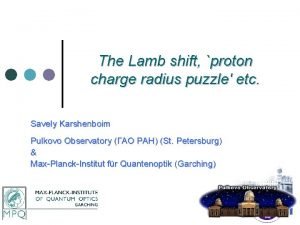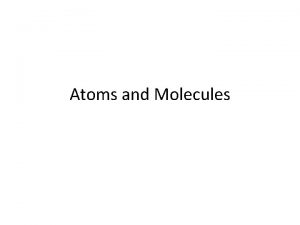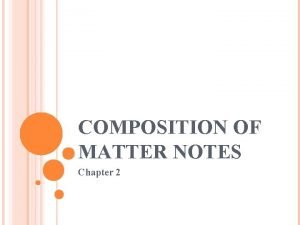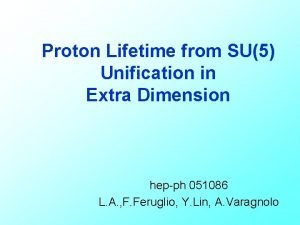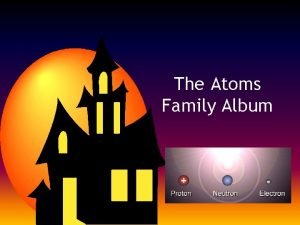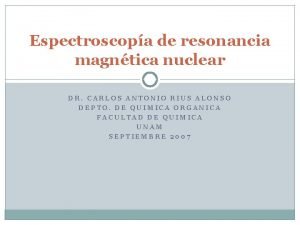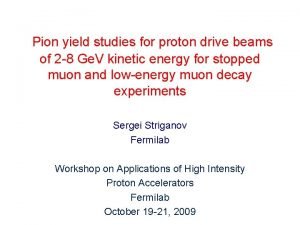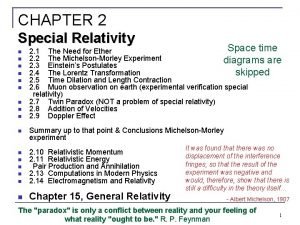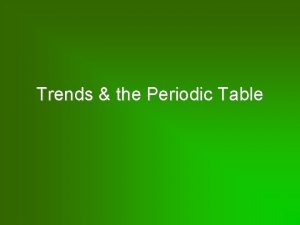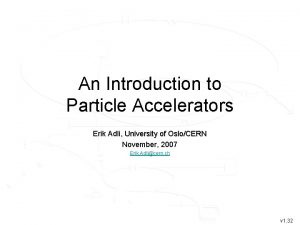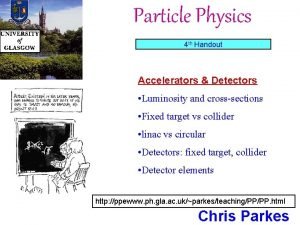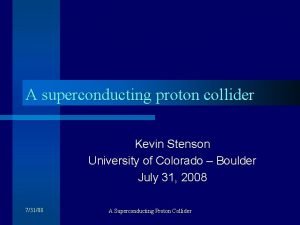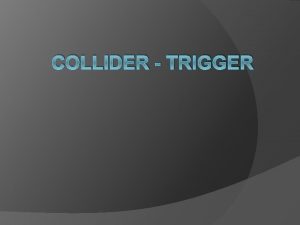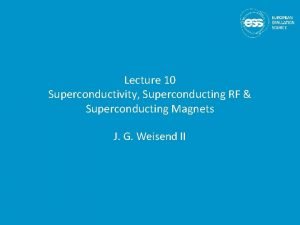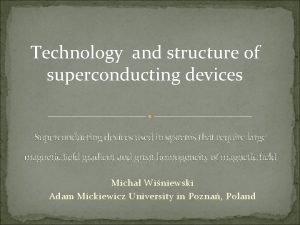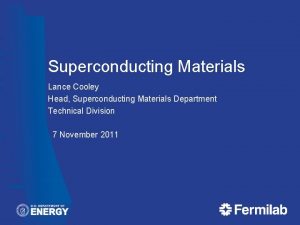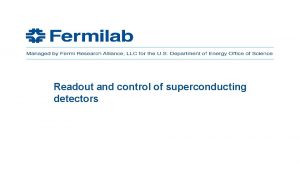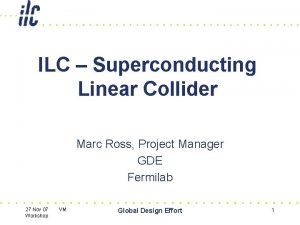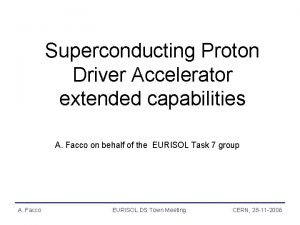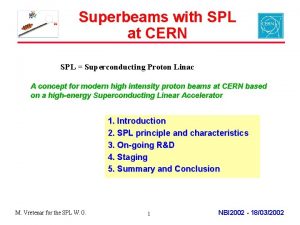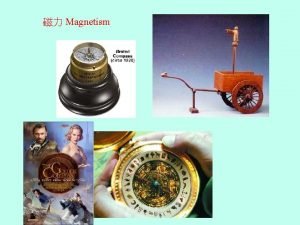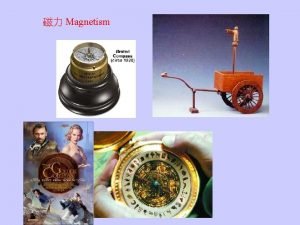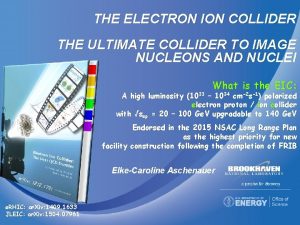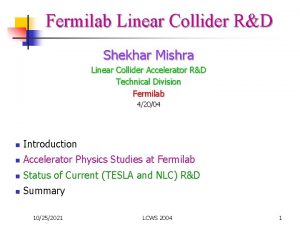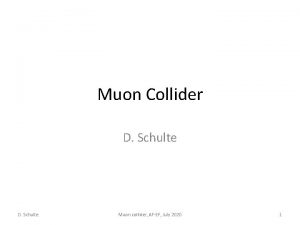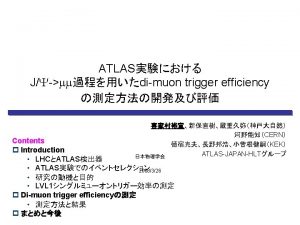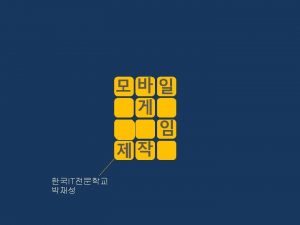A superconducting proton collider Kevin Stenson University of



































- Slides: 35

A superconducting proton collider Kevin Stenson University of Colorado – Boulder March 14, 2009 3/14/09 A Superconducting Proton Collider

What is particle physics? Particle physics is the ultimate reductionist science and seeks to answer just two questions: What are the fundamental building blocks (particles) in nature? and What is the nature of the forces acting between the particles? First I will tell you what we know, starting with the fundamental particles… 3/14/09 A Superconducting Proton Collider 2

Inside a helium atom Atoms are made up of a nucleus surrounded by electrons. Neutral helium has 2 electrons. The nucleus contains protons and neutrons. (Helium has 2 protons). The protons and neutrons are composed of up and down quarks. 3/14/09 n p n d d u A Superconducting Proton Collider p u d u 3

The Fundamental Particles Although only 2 quarks (up and down) are needed to make up normal matter, there are two other pairs for a total of 6. (Nobody knows why this is so. ) This 3 family structure extends to particles like electrons. There are 2 particles like the electron plus a set of 3 neutrinos. The 2 nd and 3 rd generation particles have more mass and are “unstable” which means they decay into 1 st generation particles. This happens in a tiny fraction of a second. 3/14/09 A Superconducting Proton Collider 4

Fundamental forces The second part of particle physics is figuring out the interactions (forces between particles). We know of 4: Gravity: important for big objects & long distances (keeps Earth from escaping Sun); negligible in particle physics. Electromagnetism: causes opposite charges to attract (keeps negative electrons from escaping the positive nucleus). Causes lightning and compass behavior. Strong force: causes quarks to attract, keeps quarks inside proton and neutron and keeps protons and neutrons inside the nucleus. Weak force: Causes radioactive decay; for example of the radon inside your basement. 3/14/09 A Superconducting Proton Collider 5

The Standard Model of particle physics l Matter is made up of 3 families of quarks & leptons l In quantum physics there is a force particle (carrier) that communicates the force between particles. l 3 forces with force carriers § Electromagnetism carried by photons § Weak force carried by W & Z § Strong force carried by gluons All of these particles have been detected by particle physicists. 3/14/09 A Superconducting Proton Collider 6

The Higgs Particle The Standard Model has been around for 40 years. Only 1 particle of the Standard Model is left to be found. It is called the Higgs particle (after Peter Higgs who came up with the idea in 1964). The Standard Model supposes that a Higgs field exists throughout the universe and is what gives fundamental particles their mass. There should also be a Higgs particle associated with the Higgs field. This is one of the things we are looking for. If the Higgs particle (or something like it) does not exist the whole Standard Model will fall apart. 3/14/09 A Superconducting Proton Collider 7

How does Higgs give mass to particles? In the normal world, more mass corresponds to more protons and neutrons. 2 gallons of water is twice as massive as 1 gallon of water because there are twice > as many water molecules so twice as many protons and neutrons. But quarks aren’t made up of anything else. So where do they get their mass from? Each quark is connected to the Higgs field. The stronger the connection, the greater the mass. So really the mass is just the strength of the connection to the Higgs field. This mass behaves just like normal mass. 3/14/09 A Superconducting Proton Collider 8

How do we find the Higgs particle? l Need a high energy accelerator to produce the interesting particles l Need detectors to record what happens when the particles decay l Need to separate the interesting stuff from the background 3/14/09 A Superconducting Proton Collider 9

The particle accelerator The Higgs particle is unstable and so it decays into other particles immediately after being created. This means we need to make our own Higgs particles. The most famous formula in physics gives us the prescription. E=mc 2 tells us that mass and energy are equivalent. An atomic bomb converts a small amount of mass into energy. We do the opposite. With enough energy, you can create mass such as a Higgs particle. The name of the accelerator is the Large Hadron Collider (LHC) and is located at CERN (European Center for Nuclear Research). 3/14/09 A Superconducting Proton Collider 10

Alps LHC Lake Geneva airport CERN is on the French. Swiss border near Geneva. CMS The LHC is 17 miles around and located 100 -500 feet underground 3/14/09 A Superconducting Proton Collider 11

How the LHC works Accelerate protons to a very high speed (99. 999999% of the speed of light) The proton energy is 7000 times greater than at rest. Natural tendency of moving particles is to move in a straight line. Use powerful superconducting magnets to bend protons so they go in a circle. The reason the accelerator is so large is because we cannot make stronger magnets. We actually accelerate protons in both directions and at 4 places we steer the protons into each other to collide. 3/14/09 A Superconducting Proton Collider 12

3/14/09 A Superconducting Proton Collider 13

LHC Detectors to record the events 3/14/09 A Superconducting Proton Collider 14

Detecting the particles We collide two protons at very high energy to create a Higgs particle. But the Higgs immediately decays into other particles. We need to detect these particles to reconstruct what happened. The CMS detector is in an excavated cavern 300 feet underground. 3/14/09 A Superconducting Proton Collider 15

CMS Slice Different particles behave differently as they go through the detector. This lets us identify them and measure their energy. 3/14/09 A Superconducting Proton Collider 16

Goes inside CMS tracker uses 2300 square feet of silicon CMS tracker being inserted into CMS 3/14/09 A Superconducting Proton Collider 17

CMS silicon pixel detector Smallest detector but the most channels. There are 65 million pixels, each 4/1000 of an inch by 6/1000 of an inch. Inserting the detector 3/14/09 A Superconducting Proton Collider 18

CMS HCAL Shown here ready to be inserted. l Measures energy of particles. l Brass absorber from Russian artillery shells is what the particles hit. l Scintillating tiles with wavelength shifting fiber between the brass layers are used to measure the energy. l 3/14/09 A Superconducting Proton Collider 19

Muon detector l Muons interact less than other charged particles l Place detectors after lots of steel and whatever comes through is a muon l We use 12000 tons of steel. 3/14/09 A Superconducting Proton Collider 20

CMS assembly 3/14/09 2005 2006 2007 2008 A Superconducting Proton Collider 21

Last step: finding the Higgs Protons collide 40 million times a second, generating 1 Megabyte of data each time. This is 40 Terabytes/second (40 disk drives per second) Only 1 in a trillion of these will have a Higgs particle we can find. Some of the other events may look like a Higgs but are not (this is background). The challenge is separating the two. We reject 99. 9998% of events immediately and save the rest. This is about 10 Terabytes/day or 1000 Terabytes/year. Thousands of computers around the world process the data. 3/14/09 Simulated event A Superconducting Proton Collider 22

What is beyond the Higgs? l From other evidence, we know that there is a theory beyond what we understand so we will be looking for signs of that. This could be: § § Supersymmetry Warped extra dimensions Extra particles Signs of string theory 3/14/09 A Superconducting Proton Collider 23

Beyond the Standard Model What is Supersymmetry (SUSY)? l In SUSY, every elementary particle has a supersymmetric partner with a different spin l Sparticles get cool names like squark, slepton, stau, wino, gaugino, photino, higgsino. So far no sparticles have been observed. 3/14/09 A Superconducting Proton Collider 24

Why do we need Supersymmetry (SUSY)? Supersymmetry has four things going for it. 1. It makes a grand unified theory more likely 2. It can solve the hierarchy problem 3. It may explain the mystery of dark matter 4. It is predicted by string theory so, if observed, it may be interpreted as evidence for string theory. 3/14/09 A Superconducting Proton Collider 25

Grand Unified Theories (GUT) The LHC works at an energy around 104 Ge. V. l At this energy, the various forces all have different strengths. l At energies ~1016 Ge. V the forces seem to come together. l Maybe they are all part of one force at this energy. l Standard model + Supersymmetry Adding in the effects of supersymmetry gives even better agreement. 3/14/09 A Superconducting Proton Collider 26

The Hierarchy Problem The Standard Model works from 0 Ge. V to the LHC energy (104 Ge. V). We assume there is some Grand Unified Theory at 1016 Ge. V. If so, the natural mass for the Higgs particle is at 1016 Ge. V. But we need the Higgs to be less than 104 Ge. V to be of use. Requiring a mass which should naturally be at 1016 Ge. V to be at 104 Ge. V is considered unnatural. Supersymmetry solves this problem in an elegant way. This is really the main motivation for supersymmetry. 3/14/09 A Superconducting Proton Collider 27

SUSY could explain dark matter Galaxy rotation curves & cluster motion, cosmic microwave background, distant supernovae, big-bang nucleosynthesis, inflation, and simulations of structure formation all give a consistent picture. Dark energy is a complete mystery. It could be that a supersymmetric particle is responsible for the cold dark matter. 3/14/09 A Superconducting Proton Collider 28

Summary of some of the physics l Higgs search § Completes the Standard Model of particle physics § Or, if not found, confuses an awful lot of physicists l Supersymmetry search § Could solve hierarchy problem, explain dark matter, allow for a grand unified theory, and even give some evidence for string theory l Other physics – could be things we haven’t even dreamed of. 3/14/09 A Superconducting Proton Collider 29

Is it safe? In 2008, the LHC received publicity regarding the safety of the Earth when the particles start colliding. There was even a lawsuit filed to stop operation. A safety study initially performed in 2003 was updated and released in June 2008 confirming that it is safe. The universe has natural particle accelerators which create cosmic rays at much higher energy than the LHC can produce. These cosmic rays have been hitting the Earth and other planets, stars, etc. for billions of years with no ill effects so there is no reason to expect problems from LHC operation. This also agrees with our understanding of the physics. Any black holes created by the LHC would evaporate immediately. 3/14/09 A Superconducting Proton Collider 30

Status and outlook Wasn’t this machine supposed to be turned on months ago? On September 10, 2008 the LHC was “turned on” amidst great fanfare. “Turning on” entailed circulating low energy protons in both directions (no collisions though). Then, on September 19, 2008 an incident occurred Recovery from this incident including retrofitting to prevent a similar incident from occurring will be complete in August. The LHC should restart sometime this fall and take data for a full year. 3/14/09 A Superconducting Proton Collider 31

The 9/19/08 incident The magnets which keep the protons moving in a circle are made of superconducting cable. This cable uses liquid helium to maintain a temperature of 1. 9 above absolute zero. Due to a bad splice, part of the superconductor cable became normal conducting and the 9000 amps of current flowing through quickly vaporized the splice. Through a chain of events, this caused much of the helium liquid which was cooling the superconductor to turn to gas. The pressure from the venting helium gas caused large forces, destroying the beam vacuum and damaging bellows. 3/14/09 A Superconducting Proton Collider 32

Connections to cosmology Particle physics seeks to find the fundamental theory of the universe as a goal in and of itself. However, particle physics also has several direct connections to our understanding of the universe. LHC collisions are like the universe 1 picosecond (10 -12 sec) after the Big Bang when the universe was basketball sized. We are probing the origins of the universe. Also, 96% of the universe is dark matter and dark energy. We might find the source of dark matter at the LHC if we find the right type of supersymmetry. Particle physics should also be able to explain the dark energy but so far the calculations are way off. 3/14/09 A Superconducting Proton Collider 33

Take home message After 15 years and several billion dollars, the program at the Large Hadron Collider begins in earnest this fall. l What we learn at the LHC in the next few years will have a profound impact on our understanding of the fundamental theory of the universe including the origin of mass. l We will be exploring an unknown energy range and so we will likely encounter some interesting surprises. l 3/14/09 A Superconducting Proton Collider 34

3/14/09 A Superconducting Proton Collider 35
 Proton proton chain
Proton proton chain Fission definition
Fission definition Proton proton chain
Proton proton chain Superconducting tunnel junction
Superconducting tunnel junction Mkid
Mkid Superconducting tunnel junction
Superconducting tunnel junction Pascal febvre
Pascal febvre Diamagnetic levitation
Diamagnetic levitation Superconducting tunnel junction
Superconducting tunnel junction Western superconducting
Western superconducting Superconducting devices in quantum optics
Superconducting devices in quantum optics Coband
Coband Youtube.com
Youtube.com Oxford superconducting technology
Oxford superconducting technology Language
Language Fcc-ee
Fcc-ee Fcc collider
Fcc collider Fcc collider
Fcc collider Unity sphere collider
Unity sphere collider International linear collider
International linear collider Bnl
Bnl Hadron collider
Hadron collider Muon collider
Muon collider Hadron collider
Hadron collider Proton charge
Proton charge What element
What element Composition of matter notes
Composition of matter notes Dalton element sembolleri
Dalton element sembolleri Proton lifetime plan
Proton lifetime plan Atoms family album
Atoms family album Protones diastereotópicos
Protones diastereotópicos Protondrive
Protondrive Rest energy of a proton
Rest energy of a proton Proton pulling power
Proton pulling power Particle accelerator formula
Particle accelerator formula Positron vs proton
Positron vs proton

